 ~by Richard Jauron, Willy Klein, ISU Extension & Outreach
~by Richard Jauron, Willy Klein, ISU Extension & Outreach
A lawn’s overall appearance is directly related to the maintenance provided. Iowa State University Extension and Outreach horticulturists offer tips on lawn mowing this week. For more information, contact the ISU Hortline at 515-294-3108 or hortline@iastate.edu.
What is the proper mowing height when mowing the lawn?
Mow Kentucky bluegrass lawns at a height of 2.5 to 3 inches during the cool weather of spring and fall. Mow Kentucky bluegrass lawns at a height of 3 to 3.5 inches in summer (June, July and August). A higher mowing height in summer helps to cool the crowns of the turfgrass plants and provides more leaf area for photosynthesis during the stressful warm summer months.
How frequently should the lawn be mowed?
Mowing frequency is based on the growth rate of the turfgrass. The growth rate of grass depends upon cultural practices, such as fertilization and irrigation practices, weather conditions and other environmental factors.
As a general rule, never remove more than one-third of the total leaf surface at any one mowing. For example, to maintain a lawn at 3 inches, the grass should be mowed when it reaches a height of 4.5 inches. In spring, it may be necessary to mow every four to five days. Once every seven to 10 days may be sufficient in summer. In prolonged dry periods, it may not be necessary to mow at all. Lawns typically require more frequent mowing again in fall with the return of favorable weather conditions.
Should grass clippings be bagged and removed from the lawn?
When the lawn is mowed properly, grass clippings do not need to be removed or bagged. Small clippings filter down into the turf and quickly decompose, returning essential plant nutrients to the soil. Short clippings do not significantly contribute to thatch development.
It may be necessary to bag or rake up the clippings if the grass has gotten extremely tall. Piles of grass clippings deposited on the surface of the lawn may damage the grass and create an environment that favors disease development.
Which mowing practices help ensure a high quality cut?
Mow the lawn with a sharp blade. A sharp blade makes clean cuts. A dull blade tears the ends of the grass blades. The damaged tissue dries out, giving the turf surface a whitish appearance. Also, the torn leaf tissue loses greater amounts of water and increases the possibility of disease problems.
Mow the lawn when the grass is dry. Wet grass is more difficult to cut and occasionally clogs rotary mowers. In addition, wet clippings tend to clump rather than be evenly dispersed across the lawn. Finally, it’s safer to mow the lawn when the grass is dry, as there is less risk of slipping and being injured by the mower.
